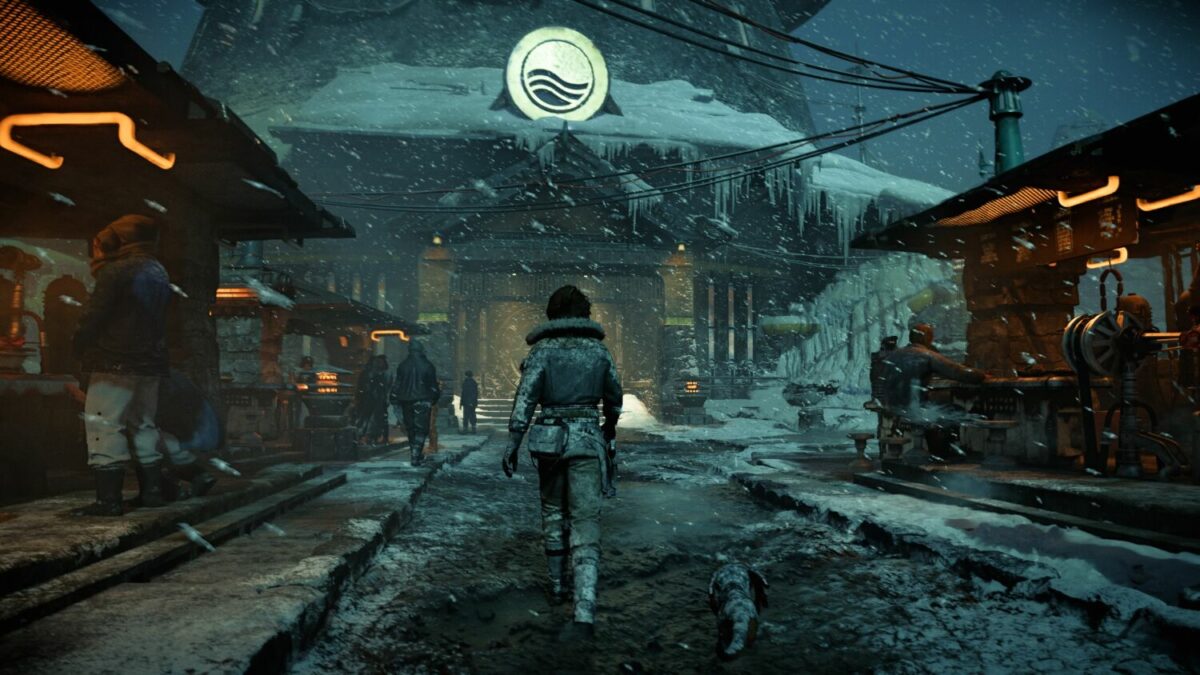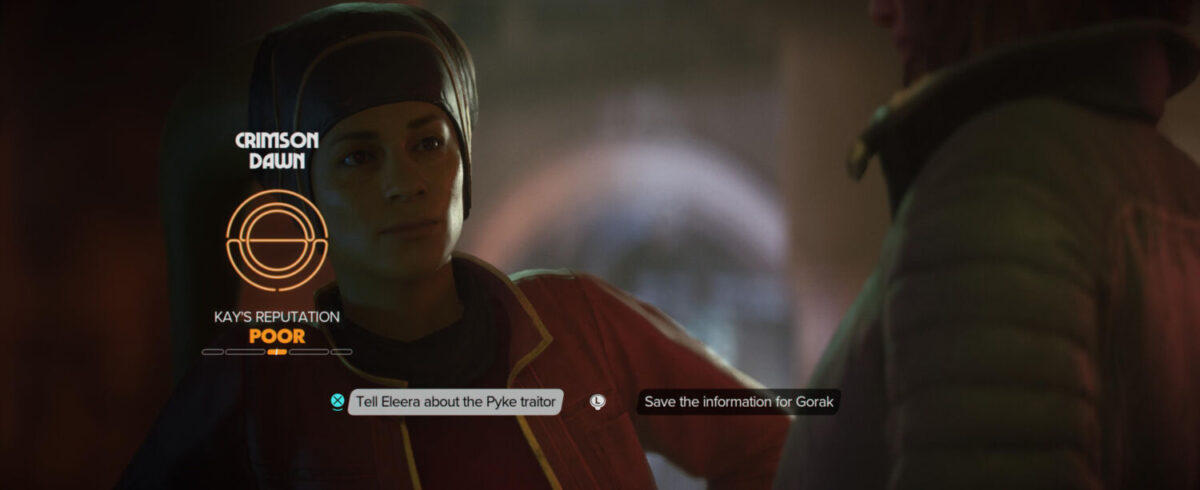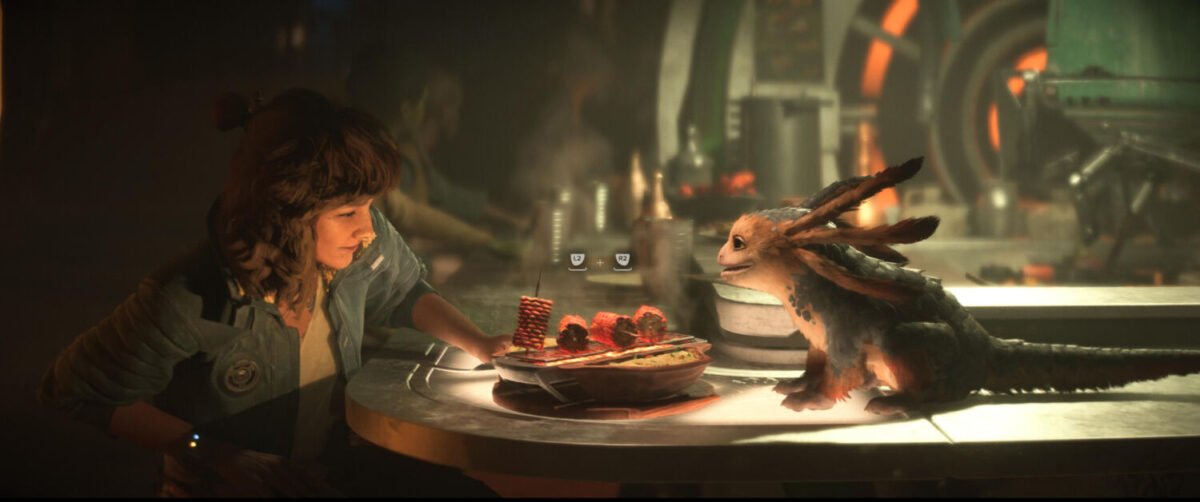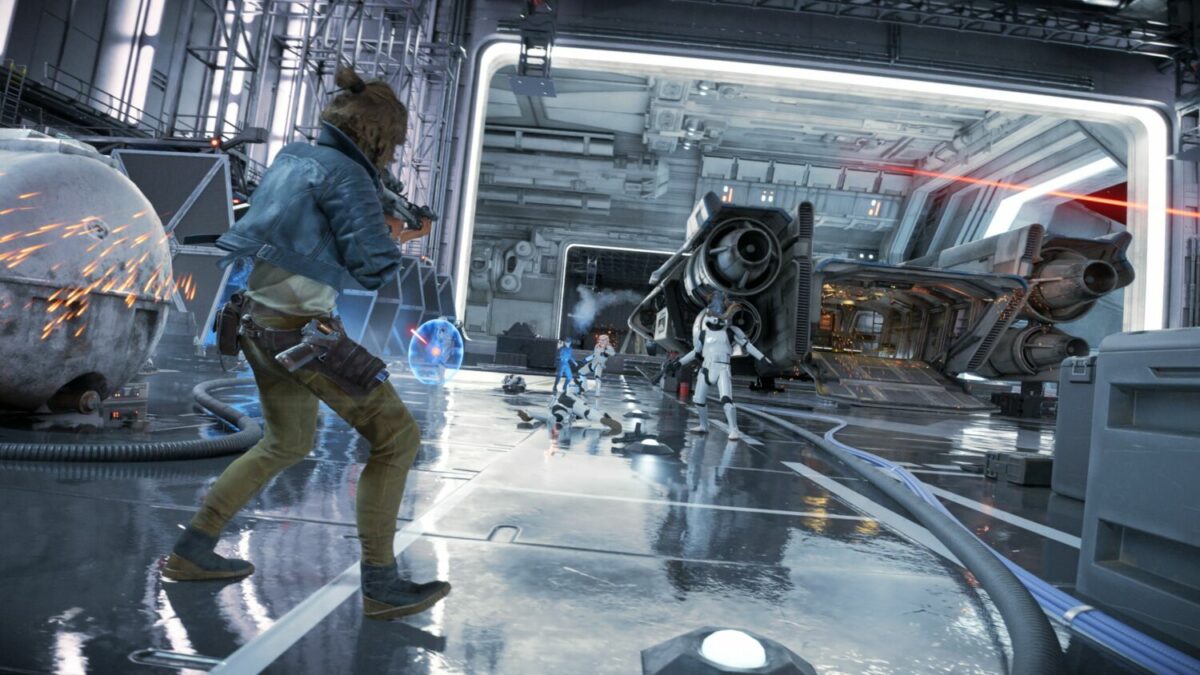The Star Wars franchise, as vast as it is, offers plenty of storytelling potential. Oozing the magic of space westerns, it has whisked fans from one galactic romp to another in various forms, including live-action films and series, animated spin-offs, comic books, novels, video games, and more – a reminder of its enduring, beloved legacy.
But straddling the line between originality and canon continuity is no mean feat. For every fresh spin on the established universe, there will inevitably be less popular or successful works, and many more ideas that didn’t see the light of the day. Stepping into the shoes of morally ambiguous characters, for example, remains uncharted territory for its games, after multiple attempts to dive into the darker parts of Star Wars lore went up in smoke.
Amid cancelled projects and vanquished dreams, Star Wars Outlaws returns with aplomb into a galaxy far, far away, taking another stab at exploring a standalone narrative. The latest undertaking from Massive Entertainment and Ubisoft marks a departure from the usual hero archetype, focusing instead on the underworld, its murky waters, and living life as a scoundrel. It’s here that players brush shoulders with criminal syndicates, cartels, smugglers, and other figures on the fringes of society, learn how to navigate turf war politics, and get down and dirty in various side missions.

After 23 hours, it delivers the long-awaited payoff that fans have been craving for. A love letter to the overall narrative fabric of the sci-fi universe, Star Wars Outlaws is a diamond in the rough with a particularly impressive grasp on worldbuilding and serves as a charming, engrossing introduction to the rougher, underrepresented parts of the galaxy. However, just as how there’s a shine to the notoriety, it also attracts some niggling issues that could do with a bit more polish.
The story follows Kay Vess (voiced by Humberly González), a young scoundrel who assembles a crew as she attempts one of the biggest heists the Outer Rim has ever seen to pay off a crime syndicate. Set between the events of The Empire Strikes Back and Return of the Jedi, it takes her – accompanied by her trusty Merqaal companion, Nix – across the planets of Toshara, Tatooine, Akiva, and Kijimi, each telling their own contained story.
Immediately, the blend of fresh and familiar elements bears a strong presence. Lore veterans would recognise the list in varying degrees: Akiva from the novel Aftermath, Kijimi as a location in The Rise of Skywalker, and of course, Tatooine, birthplace of Anakin Skywalker, but Toshara is a game-exclusive addition that draws from east African savanna. Kay, too, is a fresh face, making her debut as the first female lead of Star Wars games, and complementing her male roguish counterpart Han Solo.

New or otherwise, the open worlds in Star Wars Outlaws are a breathtaking wonder. The flora and fauna inject life into the vast wilderness of Toshara and Akiva, with the latter getting a touch of tropical weather and rainfall. In the same vein, Kijimi’s wintry landscape is equal parts bleak and bewitching, although the welcome Tatooine nod doesn’t quite cut a striking figure due to the abundance of sand, and not much else. It isn’t entirely a flaw; in fact, traits like these add plenty of personality to the planets, making them unique and distinct in their own way. Towns are where the bustle is at its highest, and they look well lived in, particularly in the market areas and cantinas.
The latter presents an interesting mechanic that fits seamlessly into the game’s setting as a scoundrel fantasy. As the main hub of information, the tavern often sees players stumbling upon valuable information through eavesdropping, such as directions to a smuggler’s cache or a hidden stash out in the wild. The feature naturally extends to other parts of the map, but it’s done in a surprisingly organic way that incentivises exploration, so remember to always keep an ear open for something interesting.

Another reason to swing by cantinas is sabacc, the popular gambling card game played by Han Solo in which he won the Millennium Falcon from smuggler Lando Calrissian. Like much of the in-universe lore, it comes with its own rules here, where players have to aim for the lowest difference between their cards. Only two are allowed in the hand any one time, and they can choose to draw from four piles, two denoting the same colour, and discard, fold, or use a charm that gives a temporary advantage, such as drawing a new card at no cost (the standard cost is one chip).
Amid the deck are imposter cards, the value of which is determined by a dice roll. There are six ranks in total, with the lower values ranked better and resulting in a “Sabacc” when the subtraction of both cards reaches zero. A Prime Sabacc occurs if there are two ‘1’ cards, and a victor is determined after three rounds.
Cheating is allowed, meaning individuals can tap into Nix and command her to take a look at the opponent’s cards. Of course, that comes with the risk of getting caught, but it’s all pretty fun and easy enough to pick up, despite the lack of an on-display reference chart – as the values aren’t written in the typical numerical system, the menu needs to be pulled up often for cross-checking.

Joining sabacc are other mini-games like retro arcade shooters and canto fathier racing, allowing for a welcome reprieve from navigating politics, completing main and side quests, space combat, and the like. In Star Wars Outlaws, Kay’s adventures are shaped by the Reputation System, which influences her interactions with the various crime bosses and underworld factions, sparking consequences for both betrayal and alliances.
There’s a catch, however. Unlike typical choice-based systems, it adds a real-time element into the mix, mapping out the rise and fall of Kay’s standing as the events unfold. From minor offenses like getting caught while infiltrating a syndicate base or trespassing on their turf out in the open to major story choices, every action shifts the status bar – sometimes a nudge, other occasions, a shove in the opposite direction.

Choosing a side involves a little strategy work as well. Apart from gameplay bonuses like special discounts, unique gear, cosmetics for Kay and Nix, as well as more contract opportunities, being on good terms with a syndicate opens up access to claimed city areas and smaller settlements, making it easier to complete certain jobs and travel on the road. Take, for instance, Tatooine, largely home to Hutt territories; if one isn’t in their good graces, expect to be attacked the moment you hover near to their turf, and have a tougher time with, well, everything.

The other three factions are Crimson Dawn, the faction led by Dryen Vos, and formerly, Darth Maul; the Pykes, first introduced in Star Wars: The Clone Wars; and the game-exclusive Ashiga Clan. Backstabbing, withholding information, and similar underhanded acts are par for the course, but the game doesn’t make it difficult to mend fences, as accepting side quests and contracts is still possible with less-than-stellar standing.
With the fluid and cohesive integration of the Reputation System, it’s unfortunate that the impact doesn’t carry over to any long-lasting outcomes in the overarching narrative, which follows a linear development. Faction allegiances don’t factor much into the major story beats, and there aren’t second choices apart from, say, engaging in combat to resolve a conflict involving groups that players are in good standing with.
Case in point: a mainline quest pits them against the Crimson Dawn, and unlike RPG contemporaries like The Elder Scrolls V: Skyrim, negotiation and alternative approaches are unavailable even as a highly-trusted member. Instead, the game forces them to fight against their own people, and it’s a jarring dissonance that fails to gel with the design philosophy as much as the other parts have.

In any case, credit should be given to Star Wars Outlaws for exploring an all-new original tale. On a fundamental level, it isn’t anything to write home about, leaving behind a couple of loose ends in its closing act and running weary storytelling tropes. There are no mind-blowing twists to speak of, and its gameplay loop is largely predictable. Where the upcoming endeavour impresses is its deft integration into the rich layers of lore, building on clever references from the larger Star Wars universe and tying them into a different medium, as well as paving the way for returning figures, including a pleasant surprise (no spoilers here!).
Characterisation is also loose. The sparse interactions between Kay and most of her allies, by design or otherwise, make it difficult to form an attachment to them, and a dull antagonist doesn’t help matters. In fact, the rapscallion herself is a bit of a curious contradiction, exhibiting behaviour that may clash with conventional expectations. There are similarities, naturally: she follows her own moral code like most outlaws, and is willing to do the dirty work. While far from an altruistic individual, compassion does frame Kay’s thoughts and fuel her actions, and the positive energy instead of a jaded portrayal, makes for a comforting presence.
But in the same breath, the protagonist also comes across as a little naive for someone who’s been in the underworld game since young. Betrayal, backstabbing, and double-dealing are a way of life; yet, she continues to fall for the same trap multiple times, which can be frustrating to witness, especially since it’s possible to be both tender-hearted and cautiously vigilant. The dialogue options for negotiation and information searches are awkward in a way that wouldn’t translate well into a realistic sequence, and don’t quite reflect the silver-tongued charm typically associated with roguish archetypes like Kay. In some cases, her characterisation plays nicely into her backstory, but this disparity can feel a little out of place in others.

The young scoundrel shines the brightest during interactions with Nix and her android companion, ND-5 (Jay Rincon, The Beekeeper), highlighting her witty, inquisitive, and easygoing nature. When not bugging the latter with questions, she initiates friendly banter and gets a better understanding of its programmed personality. With Nix, it’s an open show of affection – not only are players able to pet him for a welcome dose of serotonin, the roadside food booth found across all planets triggers a special quick-time event (QTE) that shows off the duo’s playful and endearing dynamics.
There’s a bonus treat to enjoy, too. The merquual partner-in-crime can be equipped with any of the local delicacies upon first tasting, unlocking different perks ranging from kicking grenades away from Kay to the multi-distract feature. For those who struggle with QTEs, the game’s elaborate accessibility system offers an auto-complete option, alongside a slate of thoughtful modifications which extend to audio and text settings.
It’s an important and commendable addition to Star Wars Outlaws, because a core gameplay element involves timely key inputs. Akin to rhythm titles, lockpicking requires players to grasp the tempo and press the R2 trigger to a series of clicks, with some more complicated than others. Meanwhile, hacking puzzles, known as ‘slicing’ in-game, work similarly to Wordle, in which guesswork is needed to reach a fixed combination. A yellow indicator denotes a glyph in the wrong spot, blue means both are correct, and gray represents the opposite.
As noted in our earlier preview, these segments make up a larger package that presents several possible pathways: stealth, brute force, and commanding Nix to carry out various actions like stealing items and sabotaging systems. The flexibility, however, is quickly revealed to be an illusion of choice, lending itself better to theory than execution.

For starters, infiltration is a common prerequisite for the main story, compounded with the requirement to not trigger alarms and stay undetected, which rules out the gun-and-run approach (going loud with sabotaged alarms is possible, but don’t count on it). It doesn’t help that directional cues aren’t always clear – on paper, the game encourages trial and error by having more than one way to the objective, yet this is hardly the case.
Take, for example, a main story quest that puts Kay into a highly secured Imperial facility and necessitates stealth in order to access the next area. At first glance, there are seemingly two paths available: through the top, or via the lower level, and it’s only after completing the level, following a few failed attempts, that the order came to light – the former is for the infiltration part of the mission, while the latter is designed for escape.
The experience wouldn’t be as stifling if not for the slightly clunky button prompts required for silent takedowns, or the poor autosave functionality that sets progress back by quite a fair bit. Suffice to say, compulsory stealth is easily the least enjoyable aspect of Star Wars Outlaws, exacerbated by the inconsistent AI enemies.

It’s not all gloom and doom, however. Combining both combat and sneaking mechanics improves the experience, offering added flexibility that completes the loop. Traversal works as intended, featuring familiar platforming elements like swinging, rappelling, and climbing, with finicky controls affecting enjoyment levels during timed sequences. Sticking to a more traditional scheme, Kay is only able to execute maneuvers when the key prompt appears at a specific camera angle. When done right, these sequences promise a sense of satisfaction and thrill; at their worst, the frustration can run deep.
Shooting, at the very least, feels more polished. There’s still a stilted quality to Kay’s movements, be it gliding, vaulting, or knocking an enemy out, but her shots are crisper and more punchy than before. Players will start out with just one firing mode and gain upgrade opportunities along the way, allowing them to switch between three different modes that are efficient for different use scenarios, and unlock additional perks, such as dealing more damage or the burst fire ability.
In a pinch, the adrenaline rush skill proves to be a lifesaver. Taking a page out of Red Dead Redemption 2, it resembles Arthur Morgan’s Dead Eye in that Kay can slow down time, mark up to five enemies within her line of sight (with an upgraded kit), and shoot all of them at once when the window is over. Hitting the R1 trigger adds to the gauge amid the action, and it comes at the cost of interrupting her shooting momentum.

The weapon-swapping mechanic has its fair share of flaws, too. For one, there’s a learning curve to get over, as individuals will have to pick up and adapt to the new firearm on the fly, which sports a spray pattern and recoil that may differ from another. The wielding duration isn’t permanent, so Kay will automatically drop it after a short while, or before any platforming segments. Likewise, the fickle pop-up of action prompts remains an issue here.
As a role-playing adventure, Star Wars Outlaws brings its own spin on skill progression. In lieu of ability points, the game tasks players with locating various field experts across the map, completing their initial assignment, and accomplish objectives or gather resources to unlock or level up competencies. It’s possible to get through the whole romp with some missing loadouts, serving as a refreshing change in pace from the traditional checklist presentation.
Speeder and dogfighting upgrades are included in the bag as well, so players who aren’t well-versed in these areas don’t have to fret. A franchise staple, the latter has been tailored for a more mainstream audience with beginner-friendly controls, alongside generous lock-ons and aim assist. It strikes a good balance between accessibility and delivering battle thrills, delivering a fun, engrossing time when chasing down targets.

Cruising through space is a liberating affair, but always be on the lookout for hostile factions that will attack with no mercy. Scattered across the boundless expanse are buried caches and treasure under wreckages, with Hyperspace allowing for seamless travel between planets. For an extra kick of danger, there’s always the choice to smuggle contraband – just keep your fingers crossed for no border checks.
Back on land, Kay’s speeder serves as the only mode of transport from one place of interest to another. Despite the floaty sensation, zipping down fertile, lively landscapes oozes exhilaration and unrestrained joy, even with enemies hot on the trail. Akiva’s topography is a personal favorite, allowing players to coast on large bodies of water, and discover nooks and crannies off the beaten path.
For all that Star Wars Outlaws touts an open-world design, there are no signs of the bloated elements that often plague other Ubisoft titles. Each world is carefully contained within reasonable bounds, affording a comfortable amount of freedom without going overboard. It’s easy to get around, though the lack of a mini-map can hamper navigation when there’s a fork in the road. More fast travel points would be appreciated as well, especially since their distribution across territories is uneven, and players who aren’t on friendly terms with the ruling faction have the feature disabled.

Ultimately, the fleshed out worldbuilding proves to be its crown jewel. The outpouring of passion that went into crafting the universe is evident, and its open-world structure only serves to facilitate exploration further. It’s perhaps this display that best represents the untethered nature of being an independent outlaw, where the world’s your oyster.
Star Wars Outlaws is far from the perfect culmination of snuffed promises and failed endeavours. But there’s value to be found in taking the path less travelled, and the ambitious undertaking is a testament to the promising future that lies in unearthing the darker, underrepresented parts of a galaxy far, far away. A respectable introduction to the seedy underworld, it falls a little shy of gameplay expectations, but boy, is it a visual spectacle to behold. There are certainly rough edges to iron out, though some may instead attribute these to its charm – and they wouldn’t be wrong.
GEEK REVIEW SCORE
Summary
Star Wars Outlaws is a fresh breath of air that sets up an enjoyable and charming experience of living out a scoundrel’s dream, despite several missteps.
Overall
8/10-
Gameplay - 7.5/10
7.5/10
-
Story - 7/10
7/10
-
Presentation - 9/10
9/10
-
Geek Satisfaction - 8.5/10
8.5/10













